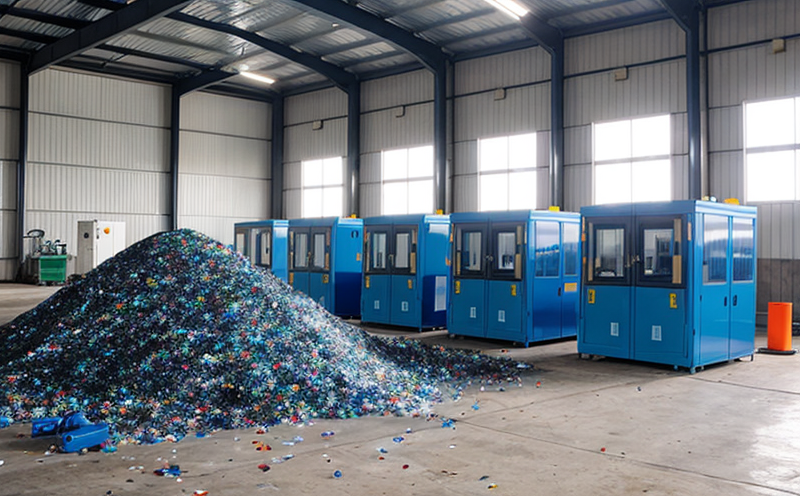ASTM D7885 Plastic Waste Pelletization Performance
The ASTM D7885-19 standard provides a method to evaluate the performance of plastic waste pellets used in recycling processes. These pellets are critical intermediates that connect waste materials to new products, ensuring efficient and effective resource recovery.
ASTM D7885 outlines key parameters for assessing the quality of these pellets through mechanical testing, including tensile strength, elongation at break, and impact resistance. Understanding how well these recycled pellets perform is crucial in recycling operations as it affects the overall quality of the final product derived from them.
The test involves subjecting the pellets to a series of standard conditions that simulate real-world usage scenarios. This testing helps ensure that the recycled plastics meet industry standards, thereby promoting sustainability and resource conservation.
One of the most significant advantages of using ASTM D7885 is its ability to provide reliable data on the performance characteristics of plastic waste pellets. By adhering to this standard, manufacturers can validate their processes and ensure consistent quality across batches.
The test procedure described in ASTM D7885 includes detailed steps for sample preparation, conditioning, and testing under controlled environmental conditions. This ensures that all measurements are comparable and reproducible.
| Test Parameter | Description |
|---|---|
| Tensile Strength | The maximum stress a sample can withstand before breaking, measured in MPa (megapascals). |
| Elongation at Break | The percentage elongation of the specimen when it breaks. |
| Impact Resistance | The energy absorbed by the specimen before fracture under impact loading. |
These parameters are critical for assessing the durability and integrity of plastic waste pellets. By accurately measuring these values, manufacturers can ensure that their recycled materials meet or exceed industry standards.
In addition to mechanical properties, ASTM D7885 also considers other factors such as particle size distribution and moisture content which can influence processing efficiency and final product quality.
The use of this standard not only enhances the reliability of plastic waste recycling but also promotes a more efficient circular economy. By ensuring that recycled materials are consistent in quality, manufacturers can reduce costs associated with raw material procurement while contributing positively to environmental sustainability goals.
Why It Matters
The importance of ASTM D7885 cannot be overstated as it plays a vital role in the plastic recycling industry. This standard ensures that recycled plastic waste pellets are suitable for use in various applications, thereby promoting resource efficiency and reducing reliance on virgin plastics.
- Enhances quality control by providing standardized methods for testing.
- Promotes consistent performance across different batches of recycled materials.
- Supports sustainable practices through efficient material reuse.
- Aids in meeting regulatory requirements imposed by governments worldwide.
By leveraging ASTM D7885, companies can demonstrate their commitment to environmental stewardship and contribute towards achieving global sustainability targets. The standard also facilitates better communication between stakeholders involved in the recycling supply chain, from raw material suppliers to end-users of recycled products.
Environmental and Sustainability Contributions
The implementation of ASTM D7885 contributes significantly to environmental protection efforts by reducing waste sent to landfills. By promoting the reuse of plastic waste through recycling, this standard helps minimize greenhouse gas emissions associated with producing new plastics from raw materials.
Incorporating recycled content into products also reduces energy consumption and water usage during manufacturing processes compared to traditional methods. Additionally, it decreases dependency on fossil fuel-based resources, further enhancing environmental benefits.
Furthermore, the use of ASTM D7885 ensures that only high-quality recycled pellets are used in downstream applications, leading to higher quality final products. This not only improves product performance but also increases customer satisfaction and loyalty among end-users.
The standard's focus on maintaining consistent quality throughout the recycling process aligns with broader sustainability goals aimed at creating a closed-loop economy where resources are continually reused rather than discarded after single-use.
Use Cases and Application Examples
| Application Example | Description |
|---|---|
| Manufacturing composite materials | Polymer waste pellets can be blended with other additives to create durable composites used in construction or automotive industries. |
| Producing packaging materials | Recycled pellets may be repurposed into lightweight, flexible containers for food and beverage products. |
| Creating consumer goods | High-quality recycled pellets can be used to manufacture everyday items like bottles, toys, or household appliances. |
In addition to these examples, the flexibility provided by ASTM D7885 allows for innovative approaches in developing novel applications tailored to specific market needs. For instance, some companies are exploring biodegradable plastics made entirely from recycled waste streams, which could have significant implications for reducing plastic pollution.
- Bioplastics production: Recycled pellets can serve as raw materials for producing biodegradable plastics that decompose faster than conventional petroleum-based alternatives.
- Furniture manufacturing: Pellets derived from old furniture could be processed into new pieces, extending their lifecycle and reducing waste.
The versatility of ASTM D7885 enables various industries to incorporate recycled content effectively, fostering innovation in sustainable practices.





